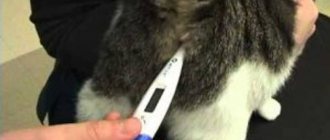7703Administration
Many owners of sterilized four-legged friends are very interested in whether a neutered cat can mate with a cat. In reality, this happens quite often. But only taking into account the fact that the pet has already had experience in sexual activity. If we take any other situations, then this is excluded.
Some veterinary clinics keep such cats in order to mate with females, knocking down the desire. As a result, it turns out that both animals received satisfaction of instincts, but without consequences in the form of offspring.
If the cat has not mated before the procedure, it is likely that he will not show any interest after it. Often they simply forget about their adventures and natural call, living a full and active life.
It also happens that a neutered cat may demand a cat. Don't worry about it, because everything is easily explained. After surgery, the animal’s body retains a fairly large level of testosterone, which will go away over time. Therefore, owners just need to stock up on a little patience and try to limit meetings with the opposite sex.
Reasons for attraction to females
How can you live without such touching creatures as cats? While the animal is small, it brings a lot of positive emotions and impressions. But when he grows up, problems begin, as natural intuition takes precedence over creation.
© shutterstock
And then only one thought comes to mind - castration or sterilization. Many people believe that castration can solve all the nuances. But there are also opposite cases when the procedure does not bring positive results. Causes:
- The cat had already mated with a female before castration;
- Unfair operation;
- Little time has elapsed.
In the first case, after sterilization the cat did not completely lose interest in the cat. It’s just that on a physiological level he cannot do this, since he has already had intercourse. After castration, sex hormones will continue to be produced , leading to repeated heart-rending cries, territory marking, and desires to mate. This is why veterinarians advise carrying out the procedure until a certain age.
The second place is occupied by unqualified specialists. There is such a thing as cryptorchidism. This is when the male has one testicle in the scrotum and the second in the abdomen. Professional doctors will be able to determine this instantly, but unscrupulous ones may remain silent, performing castration as they please.
If the owner wants to get rid of the torment once and for all, he should only contact trusted clinics to avoid falling for scammers.
A castrated cat may continue to want to mate if little time has passed after the procedure. This period can last for a week, since hormonal levels do not disappear instantly. Owners need to be patient and understanding.
Why does a neutered cat try to mount cats or objects?
It is absolutely normal for an uncastrated cat to mount a cat, since this is an instinct for procreation, which is caused by the action of hormones produced in its testes. And if this behavior occurs in free-range conditions next to non-sterile cats, it will not surprise us at all. However, when a neutered cat tries to mount a cat or even another cat living next to him, this behavior begins to cause concern for many owners. It upsets owners even more when a domestic neutered cat climbs astride the leg or arm of one of the owners and begins to make characteristic movements. There are several reasons for this behavior. Most cats stop this type of behavior after neutering. However, the behavior may not stop immediately after surgery. The wait can take weeks, and in some cases, months or even years. After castration, there is a sharp decrease in testosterone levels, but testosterone, in some quantity, is still present in the cat’s blood, and how much there will be and how long it will remain in the body depends on each individual animal. Even after castration, a cat may retain the habit of littering, especially if triggered by the smell of an unsterile cat. A neutered cat may even display mating behavior on neutered cats. Animal psychologist Nikolai Dodman suggested that this may have something to do with the fact that the female does not smell like the male. Unneutered male cats can detect the scent of a cat in heat from a great distance. It is possible that a cat, even if she does not emit a cat odor while in heat, can emit enough of her everyday odor to provoke the cat to mount. That is, a cat can be provoked by the smell of even a neutered cat. Cats neutered at an older age may be more likely to display this behavior, since they have already mounted cats or objects under the influence of hormones, they remember this behavior pattern and try to repeat it after castration, when hormones no longer affect them . High levels of social stress can trigger the behavior of mounting cats or objects in the same way that marking can occur. If you let your neutered cat free range, he may encounter an unspayed female cat, and the smell of her may be enough to trigger this behavior. Some cats demonstrate mounting on pillows or toys, and awkward situations can occur when a cat lands on the arms or legs of a person, most often the owner. This behavior may indicate that the cat needs more attention and constructive ways to get rid of excess energy. How to reduce unwanted behavior Castration. If the cat is not neutered, this is obviously the first step you should take. Don't make the mistake of thinking that you just need to keep your cat away from cats. This is not only about eliminating the risk of unwanted pregnancy in cats, but also about reducing stress and creating a favorable environment for psychologically healthy behavior. Never punish. Never punish your cat for this behavior because it will only increase the stress level. A cat who is trying to get out of social stress will feel even more anxious if he is physically or verbally punished. Undesirable behavior from punishment will only increase, to the point that it can develop into aggression. Expand your vertical territory. Increase your cat's sense of security by expanding his vertical territory. This can be done with the help of cat complexes, beds on windows, hammocks and shelves on the wall. Vertical territory allows cats to establish and maintain their status without resorting to aggression or other destructive methods such as cages. Being at a height is an important factor in a cat's status. Provide an opportunity to sharpen claws. The point of the claws for a cat is of great importance and serves different purposes, and one of them is to mark its own territory. The point of the claws can help in maintaining the cat's high status. It also helps the cat relax to relieve stress. Availability of resources. Provide multiple resources in multiple locations to prevent competition and conflicts for the best resource. This means that you should provide cats (if there are several of them in the house) with more than one place to eat, more litter boxes than cats, and plenty of sleeping and hiding places to give the cats their own space. Carefully introduce new cats into the family. Adding a new male cat can cause a variety of unwanted behaviors, including cages. To reduce the chances of this happening, ensure a gradual, positive introduction of the new cat into the family. Increase the load. Increase physical and mental activity to give your cats healthy outlets for energy. Participate in interactive play sessions at least twice a day for half an hour for mature cats and at least two hours a day for young cats (up to three years old). Working to improve relationships. In addition to the above, pay attention to the specific relationship dynamics between your cats so you can help them coexist peacefully. Pay attention to warning signs Pay attention to your cat's body language. There are many signs that your cat is beginning to display unwanted behavior such as mounting a person, another cat, or something. It all can start with a “milk step”, a characteristic purring, excessive caresses (for example, when a cat furiously rubs against objects or your hands). By catching the onset of unwanted behavior in the bud, you can provide your cat with better alternatives to release pent-up energy. Place interactive toys in every room so you can easily access them if you need to redirect your cat. Even throwing a stuffed mouse, ping pong ball, or other small toy may be enough to redirect it. Try to distract your cat before he acts out. When petting your cat, watch for signs that he may be becoming overly excited. Your cat may have certain areas of his body that overstimulate him when stroked, so stick to areas that encourage relaxation. If your cat is becoming overstimulated because you're petting him for too long, be aware of this and stop petting him at the first sign of arousal.
Answer:
A unique situation! To be honest, I have never encountered this or heard from anyone... In cats, it sometimes happens that with a not very well-performed operation, a piece of the ovary begins to work for two and as a result the cat walks very actively, but in order for the CAT-neuter…. Cats remember (purely in their heads plus hormones in the blood) for about 2 months what it means to mark and love cats, but as soon as the hormones are removed, everything is forgotten! Your vet is right - the problem is in the head. But I don’t know how to help you. Please contact some “cat” site - maybe they will help you there.
I forwarded your letter to the wonderful felinologist Olga Sinitsa (I don’t know anyone who understands cats better than her). This is what she answered me:
Hmmm... The letter came to me a little truncated. What's the second thing she has there? Such situations happen. The fact is that the pituitary gland also participates in the formation of sexual desire, which, as you know, is in the brain and cannot be cut out. There is an opinion that if you sterilize before estrus, the hormones are already “able to be produced” - to put it clumsily.:):):):) I am cautious about this version. With a cat, there are a lot of cases where either one ovary was not removed (like they weren’t found), or a piece of it. These are the kinds of things I came across. But the cat...:( Is she sure of an erection? Maybe she’s just crawling on her. If there was no mating cat, it’s difficult to understand whether he mated or not...
Regarding erections... Yes, the cat has it, i.e. Let me explain, his manhood is visible, after love, she sits down to lick him (in fact, that’s the only reason I determined that he’s not just squeezing the cat). And also, why are they trying to do this on the bed?
There is no response from Olga Sinitsa yet. Why they try on the bed - I don’t know. Most cats prefer sex on hard surfaces, perhaps yours are just smarter than others and have figured out that soft ones are more comfortable. They are completely unique, a biological mystery!
Interesting articles:
- How to understand that a cat is neutered Optimal age Of course, a lot depends on the breed and individual characteristics of the animal. There are no specific deadlines...
- A castrated cat asks for a cat. Do cats want a cat after sterilization? In fact, in many veterinary clinics, under the term “sterilization”...
- The cat gives his paw General training rules To conduct a successful training, it is recommended to focus on the following prerequisites: Well-fed…
- Cryptorchid cat after castration Castrate a cryptorchid cat at home and in the veterinary clinic. What is cryptorchidism? Cryptorchidism in cats is the absence...
- A cat wants to be castrated after castration Why is castration performed, at what age to castrate a catCastration is a fairly simple surgical procedure...
What to do if a cat wants a cat after castration? This question is usually asked by owners whose pets continue to mark and scream after the procedure. How to distinguish sexual heat from an excited state and how to get rid of your pet’s bad habits as quickly as possible. General information about castrationMany owners do not want to castrate their cats because they consider the procedure difficult and dangerous. In fact, castration can hardly be called an operation; the whole process takes 15–20 minutes, the purpose of which is to remove the testes. However, castration is performed under general anesthesia, with the use of maintenance therapy, and is therefore considered a full-fledged operation. The optimal time for surgery is considered to be 7–9 months of age. In theory, a cat can be castrated from the moment the testicles descend into the scrotum. It is better to carry out the procedure before sexual desire manifests itself. Some veterinarians do not recommend surgery before 5 months of age because hormones secreted by the testes affect bone formation. However, not so long ago, studies were conducted in Europe that showed that castration at the age of 2-3 months is easier to tolerate for both females and males. Cryptorchid cats are neutered much later, at one year of age or even later. The fact is that the testicles can descend naturally. If this does not happen, castration is performed using abdominal surgery. Cryptorchid cats need to be neutered, since their risk of developing serious illnesses and inflammation of the genitourinary system is very high. After castration, cryptorchids are no different from healthy cats. Before castration, the cat needs to be prepared.
How does castration affect a cat's behavior?Castration is the only guaranteed method that allows you to eliminate a cat’s sexual desire and reduce the intensity of behavioral factors associated with this instinct. In order to understand what exactly will change in the cat’s behavior, the easiest way is to consider the habits that the cat exhibits against the background of sexual arousal. Marks are the most obvious signal from a male to attract a female. The marks are traces of special liquids (secrets) with an individual odor. Secrets may contain:
Urine marks are left in a particularly demonstrative manner - the cat lifts its tail and splashes urine. Feces marks are the same piles, only more fragrant. Even when you remove everything, the smell will remain. Very often, marks with feces are misunderstood, thinking that the cat is shitting in the house. Scratching walls, wallpaper, curtains and doors is also a way to leave marks. Heart-rending screams, especially at night, are also a manifestation of sexual desire. The cat waits until night and begins to scream heart-rendingly so that the cat hears his call and answers. Castration solves this problem almost immediately. If the cat was mated before castration, the process of balancing the hormonal levels can take up to 6-9 months. The defiant behavior and aggression that the cat began to show during sexual hunting is a natural consequence of dissatisfaction. Just don’t confuse the concepts; the cat does not experience satisfaction from mating, but it becomes very stressful if he has nowhere to throw out his accumulated energy. After castration, the cat becomes more affectionate, and mood swings disappear over time. Again, activity peaks and mood swings should not be compared. The peak of activity is when a calm cat begins to rush around, jump, and true discouragement is visible on his face. After 10–15 minutes, the pet calms down and behaves as if nothing had happened. Peaks of activity are a kind of release or a way to let off steam. |
Why do I sterilize?
People living in apartments with their beloved pets have a very difficult time going through puberty, the so-called mating period. The four-legged friend begins to behave very aggressively, scratching furniture and doors.
But what’s more terrible is when he marks the territory with rather unpleasant odors, plus he always meows as if he’s being cut. Is it possible to live normally in such dizzying conditions?
And cats that have free access to the street may disappear for a week. And they will not return until they fulfill their calling. Because of all this, owners decide to sterilize the furry one.
© shutterstock
Gulena cat: all the subtleties of the process
There is an opinion that a cat wants a cat in the spring, or more precisely, in March. And it is true... in relation to the “correct” cats living “in nature”. Natural laws tell them to walk in the spring, feed their offspring in the warm season, and in the cold, think only about survival. Unfortunately or fortunately, the sleek, mustachioed pets who live in our homes look down on this opinion. A sweet life and a good diet lead to the fact that they are ready to reproduce throughout the summer and autumn months, and even winter.
At what age does a cat start asking for a cat?
What time do cats start walking? It depends on its breed: usually a cat begins to ask for a cat for the first time in the sixth to tenth month of life. However, despite the onset of puberty before the age of one year, she is not always able to give birth to healthy babies at this time. If a cat wants a cat for the first time, it is advisable not to let them meet at least until the age of one and a half years.
Signs of estrus in a tailed “bride”
What signs in an animal's behavior indicate that a cat wants a cat? There are a lot of them, and it’s difficult not to notice the signs that a cat has gone on a spree:
- the cat screams both day and night, trying to run away from the house;
- cannot stay in one place;
- cuddles up to people and rubs against objects;
- calm cats become aggressive, and vice versa;
- rolls on the floor, lifts its tail up or to the side, tramples with its hind legs, as if squatting on them;
- loses appetite or almost refuses to eat;
- noticeable discharge from the genitals;
- urination becomes more frequent.
How often does a cat ask for a cat?
How many days does a cat walk? The duration of her estrus varies from person to person. But the end of this period, when the cat has gone on a spree, does not mean at all that the owners can relax for a long time: if the “bride” did not manage to meet the “groom”, screaming and rolling on the floor can resume after a week or two. And to the question “how many days does the cat ask for the cat?” the exhausted owners answer: “all 365 in a year!” How this looks in practice, look at the video (Alexey Karasev).
How long does a cat walk?
How long does the cat ask for the cat? The duration of estrus is usually from 7 to 20 days. If the “bride” does not become pregnant, then the “wedding requirements” will be repeated every 14-21 days until she is expecting children or the resting season begins. Occasionally, a third option is also possible, the so-called false pregnancy, which postpones the appearance of a new period when the cat wants a cat.
Stages of heat
The estrus process can be roughly divided into four stages.
- The first is called proestrus. It lasts from 1 to 4 days and is characterized by the relative calm of the animal. The beginning of the period when the cat went on a spree is indicated only by quiet throaty meows and obsessive caressing of the owners. The tailed cat is not yet ready to meet a roaming cat.
- The second period, estrus, can last 7–10 days. The female begins not just to scream, but to scream at the top of her lungs. When you stroke her back, she crouches, moving her tail to the side. This means they are ready to mate. If you want to let her have a kitten or several, it is better to bring a male on the 3rd-5th day of estrus.
- In the third period, metestrus, which lasts from 3 to 12 days, the pet that has walked with the “groom” will drive away all applicants. When fertilization does not occur, a false pregnancy may begin, very similar to the real one, but not ending in childbirth. True pregnancy in your pet lasts 60–70 days.
- In the last, fourth period, called anestrus, she calms down.
Pros and cons of castration
Naturally, every owner of a four-legged friend has his own opinion about castration. But there are also conclusions from veterinarians on this matter.
Positive sides:
- Not always, but in most cases, the male stops marking the territory;
- The open front door no longer attracts him at all;
- Good nights for the owner, as the cat does not meow when asking for a cat;
- The risk of contracting numerous diseases is greatly reduced;
- Your favorite animal will live several years longer.
Negative aspects also occur:
- Sometimes lethargy appears and laziness awakens;
- Fluffy may gain weight;
- Habits of marking territory may remain (but this is rare);
- Even less common is uncontrolled aggression and the desire to mate.
The myth of fatness
Yes, a neutered cat becomes much calmer, but this does not mean that he will gain weight.
After castration, metabolic processes in the body slow down, so high-calorie food will harm the animal. There is a chance to earn:
- Fatty liver degeneration;
- Cardiovascular failure.
To avoid obesity, you should adhere to proper nutrition and give your pet the prescribed portions of food.
There are companies that produce special dietary foods for sterilized individuals. They are low in calories, plus, prevention for the genitourinary system. The daily dosage is written on each package. Don't neglect valuable advice.
© shutterstock
Of course, you can feed natural products, but it will be difficult to calculate a balanced diet. It is recommended to exclude fish from the diet altogether. Since the contained mineral salts can lead to urolithiasis. The basic requirements are to feed your pet the prescribed amount of food in order to maintain normal physical shape.
But in fact, only the owners are to blame for the obesity of neutered cats. Since they do not find time to play with a friend, replacing attention with something tasty.
In the end, it all depends on the owner, if he treats the furry one with all the appropriate rules, then the animal will not be able to gain weight.
Suitable age for castration
A frequently asked question is the age at which surgery should be performed. Veterinarians advise castration up to a year before puberty begins. There are two reasons for this:
- The body will already be formed and will tolerate anesthesia without problems;
- Lack of sexual connection is a guarantee of further adequacy and reluctance to mate.
And in European countries, doctors recommend castration for up to four months. It has been proven that surgery at an early age will not affect the furry’s further growth and development.
Many owners are scared by the word castration. They delay the procedures, not realizing that by doing so they are harming their four-legged friend and themselves, including.
The older the animal, the more difficult it will be for him to survive the process, because he has already learned what real animal life is, and natural instincts always take precedence over reason. It also happens that after adult castration, the cat’s brain continues to give urges to mate. The result is that a neutered cat can have a female cat, but without insemination .
If the owner did not get a cat for the purpose of breeding, then early neutering is necessary to avoid many problems. There is no point in feeling sorry for or worrying about your pet.
When does a cat need to be neutered?
Experts note that the ideal age for the operation is 10 months. It was at this moment that the cat had already developed sufficiently, but had not yet fully matured sexually, so his chances of premature mating were low.
By the way, quite a few breeders keep such eunuch cats, who have retained their sexual instincts so that they can keep company with females who, for one reason or another, cannot have offspring. Having a neuter allows them to behave more calmly.











